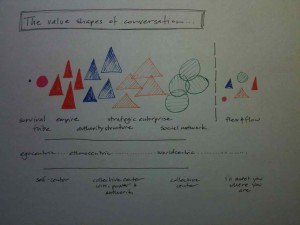One of my son’s favourite television shows is Mayday, chronicling the events leading to and resulting in airplane disasters – or in the case of a recent episode, what should have been a disaster.We found big lessons for the pilots of our communities, cities and towns.
In “Panic Over the Pacific” (Episode 6, Season 4), ChinaAirlines Flight 006 is bound for San Francisco.After an engine failure (one of four engines on a Boeing 747) that should cause no significant issues, the plane plunges 10 km in just 2 minutes.The undercarriage doors and horizontal stabilizers are ripped off the plane under the force of the plunge, yet the crew land the plane safely.By many accounts, they should not have been able to save the plane, then we find out that the plunge need not have happened in the first place.
The conclusion: the pilot caused the plunge by focusing on the one instrument that was telling him the plunge was starting and choosing not to believe it.Due to massive fatigue and jet lag, he was spatially disoriented and unable to simply adjust as needed to the engine failure.The investigators confirmed all instruments were in working order.All the pilot needed to do was look at the other instruments to see that the plunge was indeed beginning, disengage autopilot, and put his foot on a pedal.The corroborating evidence was on hand – as well as a simple solution.
The investigators offered two significant observations about this event that relate to the survival of humans on an airplane:
1.Focus on the “dashboard”, not one instrument. Attention to only one instrument – whether we believe it is right or wrong – provides us with only a sliver of information.A dashboard of instruments will send us more complete information and tell us if we are on the right track or not.Nothing is fully dependent on one instrument.
2.There is a reason why there is a human at the front of the plane. Autopilot is designed to solve the problems that we have come up with so far, but the creative human mind is needed when new problems arise that Autopilot can’t handle.In the case of our pilot over the Pacific Ocean, the pilot needed to intervene – just put a foot on a pedal.He didn’t, and they plunged to earth.
Compared to a human community, an airplane is a simple system.There is a chain of command and it is clear who is in charge.If we take a town, city, region, province, country, continent or even the planet, we can see that it is less clear who the pilot is – there are many.There are many destinations and modes of travel, but the investigators lessons still resonate and raise the following questions for a community of any scale in any setting:
1.What brings us together?What is important to us?
2.Who are we? Who has the power to get us to our destination?
3.What is our destination?What will it look like when we get there?
4.What are the wise ways to get to our destination?
5.What are diversity of skills and gifts we bring to get us there?
6.How do we knit all of the above together through the messy process of community?
In exploring the above, we find that there are many things that catch our attention; homelessness,residential densities, economic development opportunities, transportation and education systems, health care delivery, ecological impacts, parks and open spaces, opportunities for recreation, community development, energy generation, clean technologies, telecommunications, food security, urban design, emergency services, etc.There are many systems in place currently that monitor each of these.The question then is, are we watching all of them, or just one instrument like our pilot.Perhaps we do not all need to watch all of them, but we need to find ways and places to still do so.A collective sense of piloting is crucial to our survival.
This is ultimately about integrating pieces of information throughout a community system.It is about creating the time and places to connect the silos in our communities that look after the well-being of so much that makes our communities complete.A high school principal comes to mind who recently had a significant first experience: he was in the same room as people working for municipal and provincial government that were not in education.He pointed out immediately the value of this – they share interests, insights and information.How could this go further?What are the ways and places where we can attend to collectively noticing what the silos that serve us are noticing, so that we can share a common sense of direction?I offer the following:
1.Create the conditions for conversations that cross silos with the express purpose of noticing a larger picture and shared intention
2.Cultivate a common destination
3.Create a dashboard of instruments that monitor our progress to reach the destination
4.Create a culture of resilience and adaptability where change is welcome
In the case of our pilot above, his misjudgment was attributed to fatigue.I am curious about the frantic nature of work that seems so predominant these days.What are we missing by moving so fast?Are we noticing our instruments?Are we misreading them?Are we afraid of them?Are we mistakenly on autopilot? Do we have the right instruments?
How and when will we know if a Mayday call is legitimate or not?
